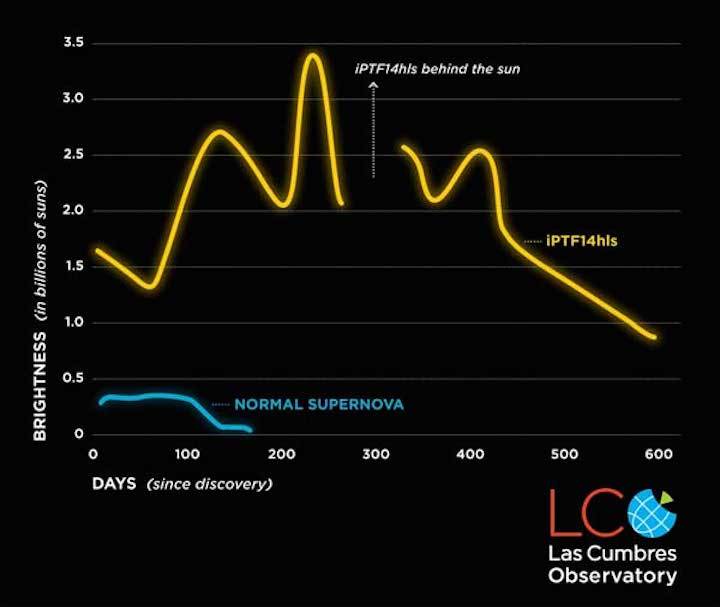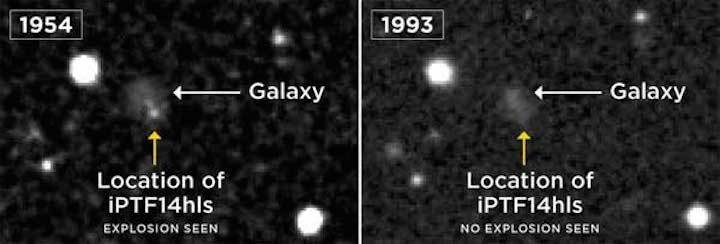Observations of a stellar explosion that refused to fade away have astronomers scratching their heads. What created the blast — and could it explain massive black holes?
How do you make a big black hole?
LIGO has witnessed four black hole collisions, the spacetime upheaval revealed in an incongruous chirp of gravitational waves. The signals tell us that these black holes each had between 20 to more than 30 times the Sun’s mass. So we know big black holes exist.

Artist's impression of a supernova remnant.
NASA / ESA / G. BACON (STSci)
Stars in our neighborhood aren’t typically that massive, though — and even if they are initially, they lose a lot of mass prior to and during a supernova explosion. Now, astronomers have observed a strange new supernova that might mark the birth of just such a beast. But the cataclysmic event holds more questions than answers.
It Just Keeps Going and Going . . .
A typical supernova explosion goes something like this: Pressure loses its sparring match against gravity when the stellar core collapses into a neutron star or black hole. But the antigravity forces have the final say — the collapse occurs so quickly that infalling layers of stellar material slam into each other, creating a reverse shock that sends much of the star flying outward. The expanding shells of ionized hydrogen glow for roughly 100 days before fading away.
That’s what Iair Arcavi (Las Cumbres Observatory and University of California, Santa Barbara) and colleagues thought they were seeing when the Intermediate Palomar Transient Factory (iPTF) caught the explosion dubbed iPTF14hls. At 18th magnitude, it appeared to be an unremarkable core-collapse supernova.
But several months later, the star re-enacted a certain Monty Python sketch — it refused to die. The star, or what was left of it, remained bright not for three months but for almost two years, radiating all the while at the same rate as 500 million Suns. Even now, three years later, it's still going strong. What’s more, it got even brighter at one point, and then again, altogether exhibiting five distinct peaks in luminosity when it should have been fading away.

iPTF14hls grew bright and dim again at least five times over two years. This behavior has never been seen in previous supernovae, which typically remain bright for approximately 100 days and then fade.
LCO / S. Wilkinson
A look back in history showed that this wasn’t the star’s first act of defiance. A possible outburst was recorded at iPTF14hls’s position in the Palomar Sky Survey back in 1954.

An image taken by the Palomar Observatory Sky Survey reveals a possible explosion in the year 1954 at the location of iPTF14hls (left), not seen in a later image taken in 1993 (right).
Credit: POSS / DSS / LCO /S. Wilkinson
There are other oddities too. As it continued shining, the hydrogen gas maintained its temperature at a steady 6000K. That makes sense if we’re seeing the glow of expanding shells of ionized hydrogen — first we’d see the outer shell then, as it expands, thins, and cools, we’d see through to the next glowing shell. But if that’s the case, then the inner shells should be traveling at slower speed, and that’s not the case here. The hydrogen gas , which started shooting out at 8,000 kilometers per second (18 million mph) only slowed down to 6,000 km/s (13 million mph). The radius of the light-emitting region also appeared to stay constant, rather than expanding outward over time.
An Exotic Explanation
Putting it all together, Arcavi and colleagues rule out most standard theoretical models for supernovae. The last one standing is one of the most exotic: a pair instability supernova (PISN). If a star is massive enough (but not too massive), the incredible temperature and pressure of its core converts photons into particles, namely electrons and their antimatter partners, positrons. The resulting instabilities set off multiple supernova-like blasts, each ejecting tens of solar masses of gas. If the star’s initial mass was just above 100 Suns, it could have produced the multiple explosions astronomers witnessed from iPTF14lhs.
But these exotic supernovae have their share of problems. For one, we’ve never definitively detected one (though candidates have been suggested in the past, and the model could explain the most luminous supernova ever observed). The explosions also require massive stars not typical of our stellar neighborhood.
“These explosions were only expected to be seen in the early universe and should be extinct today,” says coauthor Andy Howell (also at LCO and University of California, Santa Barbara). “This is like finding a dinosaur still alive today. If you found one, you would question whether it truly was a dinosaur.”
Even this exotic scenario might not even provide enough energy to explain what they’ve witnessed, the researchers argue. Simple calculations show that the observations require 20 times more energy than a PISN could provide. But Stan Woosley (University of California, Santa Cruz), author of a perspective piece that accompanies the Nature article, notes that we don’t understand pair instability supernovae well enough to invalidate the idea on this basis.
A bigger problem may be the temperature: a pair instability supernova can’t explain why the temperature would remain constant.
“As of now,” Woosley writes, “no detailed model has been published that can explain the observed emission and constant temperature of iPTF14lhs, let alone the possible eruption 60 years before the supernova.”
Could we be dealing with something entirely new? In this era of sky-scanning telescopes such as the iPTF, Catalina Sky Survey, Zwicky Transient Survey, and the Large Synoptic Survey Telescope, it’s only a matter of time before we find more sources like this one — or weirder still.
Quelle: Sky&Telescope
